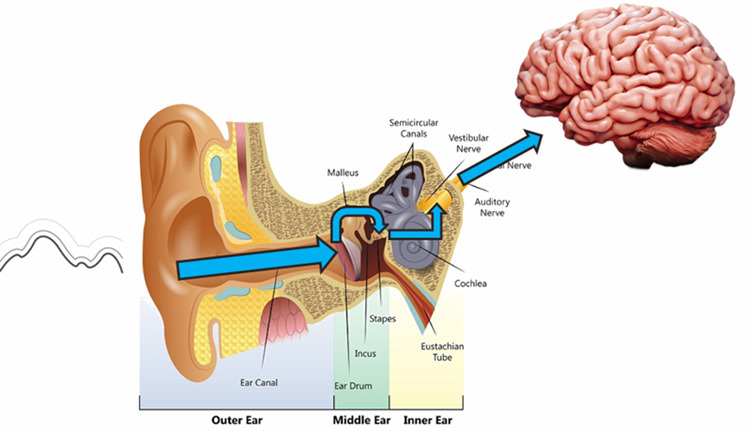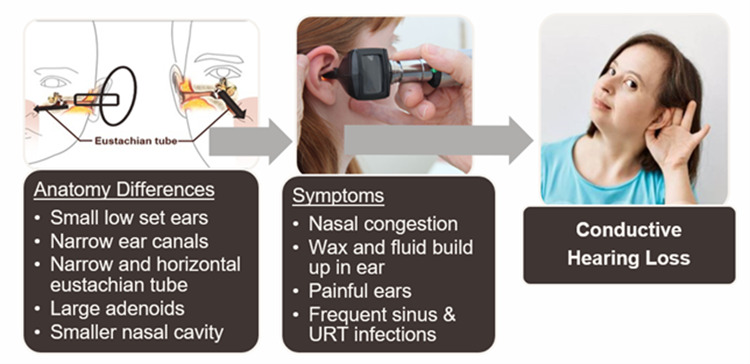Hearing
If our ears are working well, they capture sound waves and convert them into messages that our brains can understand. The ear has three main parts: outer, middle, and inner; and it is made up of bones, hairs and nerves that carry sound waves to our brain which interprets the sounds we hear. Each part of the ear needs to be working for us to hear well. We care about hearing health because people with hearing disorders are at higher risk of developing delays in their receptive language, expressive language and speech which could lead to academic, social and emotional implications. It is estimated that 50-80% of people with Down syndrome have hearing issues that range from mild to profound.

Common Hearing Disorders in Down Syndrome
Hearing Loss (What we Hear)
- Conductive Hearing Loss
- The most common type of hearing loss in Down syndrome (60 – 80%).
- Caused when sound cannot get through the outer and middle ear.
- Usually temporary and fluctuating but reoccurring. This is due to anatomical differences and weaker immune systems that make it more likely wax and/or fluid buildup will occur.
- Treatment of this hearing loss usually involves wax removal, wax softener or removing the fluid and preventing infection with surgical tubes or antibiotics.

- Sensorineural Hearing Loss
- Less common hearing loss in Down syndrome but overall, rates much higher than the general population (15 – 20%) due to a higher risk of health complications.
- Can be from birth or acquired later. Often a hearing loss related to aging, which occurs at an earlier age in Down syndrome.
- More often a permanent cause of hearing loss, due to issues with the nerve pathways to the brain.
- Mixed Hearing Loss
- Having both a conductive and sensorineural type of hearing loss.
Auditory Processing (What We Do with What We Hear)
- Central Auditory Processing Disorder (CAPD)
- Auditory Processing is the ability to identify, organize and interpret the sensory input received through hearing.
- They may hear fine but have difficulty understanding what they heard.
- With a significant correlation between auditory processing and working memory, some people think difficulties in auditory processing could be the cause of language difficulties in Down syndrome.
- Hyperacusis
- Increased sensitivity to certain sounds.
- Loud sounds may cause discomfort or distress.
- Can cause anxiety or avoidance over specific situations (e.g., malls, assemblies, animals)
- More common in populations like Autism or Down syndrome.
Treatment for Auditory Processing Related Disorders:
- Medications
- Speech-Language Therapy focused on listening skills
- Cognitive Behavioral Therapy and desensitization
- Hearing Protection
Common Signs of a Hearing Disorder
- Does not respond
- Frequent rubbing of ears
- Discharge from ear or sour smell
- Wanting to turn volume up high
- Difficulty modulating voice volume
- Difficulty understanding words or instructions
- Delayed speech and language skills
- Strong preference for visual information as opposed to auditory
- Avoidance of social situations or withdrawal
- Noisy environments are overwhelming, does better in quiet spaces
- Difficulty maintaining attention
- Problems locating source of sound
- Needs things to be repeated
- Academic difficulties particularly with reading or spelling
Since there are comorbidities and learning differences associated with Down syndrome, it is important to rule out that hearing is not contributing to the difficulties seen above. If you have any concerns about your child’s hearing or processing, speak to your healthcare providers.
Hearing Health Guidelines + Professionals
These are the people who might be involved in the care of your hearing health. You can get referrals to these professionals through your family doctor.
Audiologists
- Test for hearing disorders shown on a chart called an audiogram. They provide treatment, management and prescribe amplification devices such as:
- Hearing Aids
- Cochlear Implants
- Frequency Modulation (FM) Systems for the classroom
- Recommendations for auditory testing in Down syndrome include:
- At birth
- Every 6 months until 3 years
- Annually after that, as hearing status can always change.
Otolaryngologist/ ENT
Provide medical and surgical care related to ears, nose, and throat.
DSRF Resources
The LowDOWN Podcast, Episode 5:3: Carina Hei – Sign of the Times: The Benefits of Sign Language
Equipment Adherence Tips: Hearing Aids
Other Resources
BC Children’s – How to Read An Audiogram
